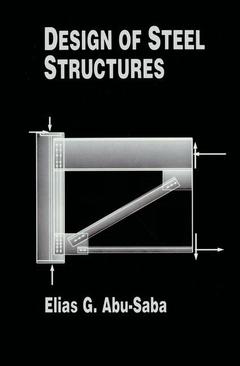Design of Steel Structures, Softcover reprint of the original 1st ed. 1995
Langue : Anglais
Auteur : Abu-Saba Elias G.

This book is intended for classroom teaching in architectural and civil engineering at the graduate and undergraduate levels. Although it has been developed from lecture notes given in structural steel design, it can be useful to practicing engineers. Many of the examples presented in this book are drawn from the field of design of structures. Design of Steel Structures can be used for one or two semesters of three hours each on the undergraduate level. For a two-semester curriculum, Chapters 1 through 8 can be used during the first semester. Heavy emphasis should be placed on Chapters 1 through 5, giving the student a brief exposure to the consideration of wind and earthquakes in the design of buildings. With the new federal requirements vis a vis wind and earthquake hazards, it is beneficial to the student to have some under standing of the underlying concepts in this field. In addition to the class lectures, the instructor should require the student to submit a term project that includes the complete structural design of a multi-story building using standard design procedures as specified by AISC Specifications. Thus, the use of the AISC Steel Construction Manual is a must in teaching this course. In the second semester, Chapters 9 through 13 should be covered. At the undergraduate level, Chapters 11 through 13 should be used on a limited basis, leaving the student more time to concentrate on composite construction and built-up girders.
Preface; Introduction; Introduction; Structural steel and its properties in construction; Applications; Loads, load factors, and load combinations; Tension members; Introduction; Design criteria; ASD method; LRFD method; Effective area of riveted and bolted tension members; Effective area for staggered holes of tension members; Tension rods in design of purlins; Limitation of length of tension members on stiffness: slenderness ration; Applications; Compression members; Introduction; Derivation of Euler's formula; Design criteria for compression members under concentric load: LFRD method; SI LRFD design criteria (Axial compression); Compression members in braced frames: ASD method; Axial compression and bending: ASD method; Reduction in live loads; Columns subject to bending and axial force in a braced system: LRFD method; Design of columns for braced and unbraced frames: ASD method; Designs of bending members; Introduction; Simple bending; Design of beams and other flexural members: ASD allowable bending stress; Deflections and vibrations of beams in bending; Design for flexure: LRFD method; Use of the load factor design selestion table Zx for shapes used as beams; Serviceability design considerations and the LFRD method; Torsion and bending; Introduction; Torsional stresses; Plane bending stresses; Combining torsional and bending stresses; Torsional end conditions; Torsional loading and end conditions; Applications; Design of bracings for wind and earthquake forces; Introduction; Wind forces; Wind velocity pressure; Selection of basic wind speed (mph); External pressures and combined external and internal pressures; Wind pressure profile against buildings; Analysis of braced frames for wind forces; Introduction to seismic design; Equivalent static force procedure; Connections; Introduction; Types of connections; Framed beam connection: bolted; Framed beam connection; welded E70XX electrodes for combination with table II and table III connections; Anchor bolts and baseplates; Introduction; Design of column baseplates; Built-up beams: plate girders; Introduction; Design of plate girders by ASD method; Approximate Method for selection of trial section; Composite construction; Introduction; Design conceptualisation and assumptions; Development of section properties; Short-cut method for determining Sxbc; Shear connectors; Bethlehem steel table for selecting Shear connectors; LRFD method: design assumptions; LRFD flexural members; Plastic analysis and design of structures; Introduction; Bending of beams; Design of beams: failure mechanism approach; Fixed end beam; Plastic hinges: mechanism of failure; Fixed end beam with multiple concentrated loads; Continuous beams; Portal frames; Minimum thickness (width-thickness ratio); Plastic analysis of gabled frames; Influence of axial forces on plastic moment; Introduction; Influence of axial forces on plastic moment capacity; Rigid connections; Introduction; Straight coener connection; Haunched connections; Haunched connections with concentrated loads; Design guides: connections; Multistory buildings: plastic design; Introduction; Aloowable stress vs. plastic design methods; Application to multistory buildings; Index
Date de parution : 10-2012
Ouvrage de 391 p.
15.5x23.5 cm
© 2024 LAVOISIER S.A.S.



